What we'll cover
The use of Human Resource Management Systems (HRM) software has become essential for HR process optimisation. HRM enables HR departments to work effectively, make data-driven decisions, and concentrate on strategic initiatives that improve employee engagement and overall organisational success by centralising employee data, automating repetitive tasks, and offering tools for payroll, performance management, onboarding, and recruitment. This guide includes all the information you require, regardless of your background as an HRM software professional, small business owner, or tech enthusiast.
What is HRM Software?
HRM software streamlines HR processes and improves overall efficiency by combining many HR tasks into a one platform, including payroll, performance reviews, hiring, and employee engagement. Software called an HRM, or human resources management system, is made to make a variety of HR duties easier, like processing payroll, handling hiring, and maintaining employee data. HRM software relieves HR employees of administrative duties by automating repetitive operations, allowing them to focus on strategic projects that promote organisational growth.
The Evolution of HRM Software
Over time, there has been a significant change in HRM software. Its capabilities were initially limited to payroll and attendance management software, but they have already been greatly increased. A variety of cutting-edge features are now included in modern HRM solutions, such as AI-powered hiring tools, employee self-service platforms that are easy to use, and real-time analytics that provide data-driven insights.
-
BambooHR
-
Remote
-
Deel
-
Paychex Flex
-
Hibob's HRIS
-
Rippling
-
ADP Workforce
-
ClearCompany
-
AFAS Software
-
Buddee
Key Features of HRM Software
Numerous elements of HRM software are intended to make HR jobs easier. Among them are:
-
Recruitment and Onboarding: Automating job advertising, application monitoring, and employee onboarding software streamlines the hiring process.
-
Payroll management: Guarantees correct processing of payroll, computation of taxes, and adherence to labour regulations.
-
Payroll management: Guarantees correct processing of payroll, computation of taxes, and adherence to labour regulations.
-
Employee Self-Service: Enables staff members to modify personal information, obtain their records, and seek time off.
-
Management of Performance: The monitors worker performance and offers instruments for goal-setting and performance evaluations.
-
Analytics and Reporting: Supports HR professionals in making data-driven choices by offering real-time insights into HR indicators.
The Benefits of HRM Software
Organisations can benefit greatly from the use of HRM software by means of streamlined procedures, improved data security, increased employee involvement, and data-driven decision-making, all of which lead to increased productivity and efficiency.
-
Increased Productivity and Efficiency
HR personnel may concentrate on strategic objectives instead of administrative activities by using HRM software to automate repetitive operations. This leads to higher productivity and efficiency throughout the entire firm.
-
Better Information Administration
HRM software simplifies access, management, and analysis of employee data by centralising it into a single database, allowing for data-driven decision-making.
-
Improved Risk Management and Compliance
HRM software reduces the chance of mistakes in crucial HR tasks like payroll processing and tax calculations while also protecting your company by guaranteeing tight compliance with labour laws and regulations.
-
Improved Workplace Environment
Employee self-service portals improve the working environment for staff members by expediting access to critical data and making administrative duties like requesting time off and updating personal information easier.
-
Savings on Costs
Through the automation and simplification of HR procedures, software can dramatically save organisational costs while boosting productivity.
How to Choose the Right HRM Software?
Choosing the best HRM software for your company can be a difficult task. Making an informed decision that supports your business objectives and improves HR efficiency requires carefully assessing your unique needs, taking into account a range of features and functionalities, and thoroughly researching the available possibilities.
-
Evaluate Your Requirements
Start by carefully reviewing your organisation's HR requirements and identifying the key components and duties that are critical to the success of your HR department.
-
Examine and contrast your options
Compare features, prices, and user reviews of several solutions to determine which HRM system is best. Choose a software that fits your budget and needs precisely, making sure it takes care of your HR management needs.
-
Think about Scalability
Select an HRM system that expands with your business. As your company grows, be sure the software can accommodate more employees and extra HR duties.
-
Verify Integration Capabilities
Choose an HRM system that will grow with your company. It should be able to handle an increasing workforce management software and add new HR features as your company develops.
-
Make a Demo Request
We urge you to participate in a demo or trial to get a firsthand look at the features and usability of our HRM software. This practical method will offer insightful information about how the software functions in real-world scenarios.
Implementing HRM Software
The next crucial stage is to successfully implement the selected HRM software; to guarantee a smooth transition and optimise the advantages of the new system, proper planning is needed.
-
Make a plan and get ready.
A thorough implementation strategy is essential to a rollout's success. This plan should include all the required resources to steer the process effectively, as well as a detailed description of each stage and a clear schedule.
-
Educate Your Group
Provide in-depth training for HR personnel and other pertinent staff members to guarantee that the HRM software is used effectively and that all of its features and functionalities are understood.
-
Transfer Data
It is crucial to carefully move employee data from the old HRM platform to the new one. Strict attention to detail is needed throughout this procedure to ensure that all employee data is moved entirely and appropriately.
-
Examine and confirm
Before the software is put into use, it must be thoroughly tested and validated to make sure all of the features work as intended and meet the unique requirements of the organisation.
-
Observe and maximise
Continuous post-implementation performance management system of the HRIS software is crucial. Through the process of collecting and evaluating user feedback, modifications can be implemented to enhance the functionality and efficiency of the product.
Real-World Applications of HRM Software
Enterprises across all sectors and sizes use HRM software. Here are a few instances of actual applications for HRM software:
-
Simplifying the Hiring Process at Corporation
By using an HRM solution, automating job advertisements, application monitoring, and applicant interactions, the company expedited its hiring process and ultimately decreased the time-to-hire by 30%.
-
Increasing Workplace Morale at ABC Inc
successfully increased staff engagement with HRM software implementation. The employee self-service portal of the program enabled machine ethics staff members to conveniently retrieve information and oversee assignments, leading to a rise in contentment and general involvement within the company.
-
Enhancing Obligation at DEF Enterprises
By using HRM software, DEF Enterprises greatly increased compliance with employment laws. The automated compliance capabilities of the software effectively mitigated the danger of errors and related penalties, giving the HR team a piece of mind and guaranteeing compliance with rules.
The Future of HRM Software
Emerging trends like AI-powered decision making, individualised employee experiences, data-driven workforce planning, and the growing integration of HR services throughout the organisation will drive the future growth of HRM software.
-
Both machine learning and artificial intelligence
HRM software is undergoing a transformation thanks to artificial intelligence and machine learning, which are giving it access to advanced features like predictive analytics to foresee trends in the workforce and AI-driven recruitment to maximise talent management software acquisition.
-
Mobility
With the rise in remote work, mobile accessibility has become an essential feature of HRM software. Employee flexibility and convenience are increased as they can now easily access HR tasks from their mobile devices.
-
Employee Welfare and Mental Health
With options for stress management, wellness programs, and mental health services, HRM software is changing to emphasise employee wellbeing and mental health.
-
A greater emphasis on inclusion and diversity
With the goal of promoting a more fair and representative workplace, HRM software is changing to prioritise diversity and inclusion by introducing tools like bias detection and inclusive recruiting practices.
-
Blockchain Methods
The potential of blockchain technology to improve data security and transparency in HRM software is being researched. This could improve the accuracy and dependability of HR data.
Conclusion
Implementing Human Resource Management System (HRM) software is a transformative step for organisations aiming to streamline their HR processes and enhance overall productivity. For businesses operating in the SaaS landscape, leveraging an HRM not only simplifies administrative tasks but also provides valuable data insights that inform strategic decision-making. As the workforce landscape continues to evolve, embracing HRM solutions can lead to improved employee engagement, better compliance management, and increased operational efficiency. With the right HRM software, companies can remain agile and competitive in today's fast-paced environment. For those exploring options in the USA, SaaS Adviser serves as a valuable resource to help identify and select the most suitable HRM solutions tailored to specific business needs.
HRM (Human Resource Management) software is a digital solution designed to automate and streamline HR processes such as recruitment, payroll, performance management, and employee records.
Key features include employee data management, payroll processing, benefits administration, time and attendance tracking, recruitment management, performance evaluation, and training management.
HRM software improves efficiency by automating HR tasks, reduces errors in payroll and benefits administration, enhances employee engagement, and provides valuable insights through data analytics.
Yes, many HRM software solutions offer customization options to tailor features and workflows to match the unique requirements of different businesses.
Absolutely. HRM software can be beneficial for businesses of all sizes by simplifying HR tasks, improving compliance, and providing tools for better employee management.




